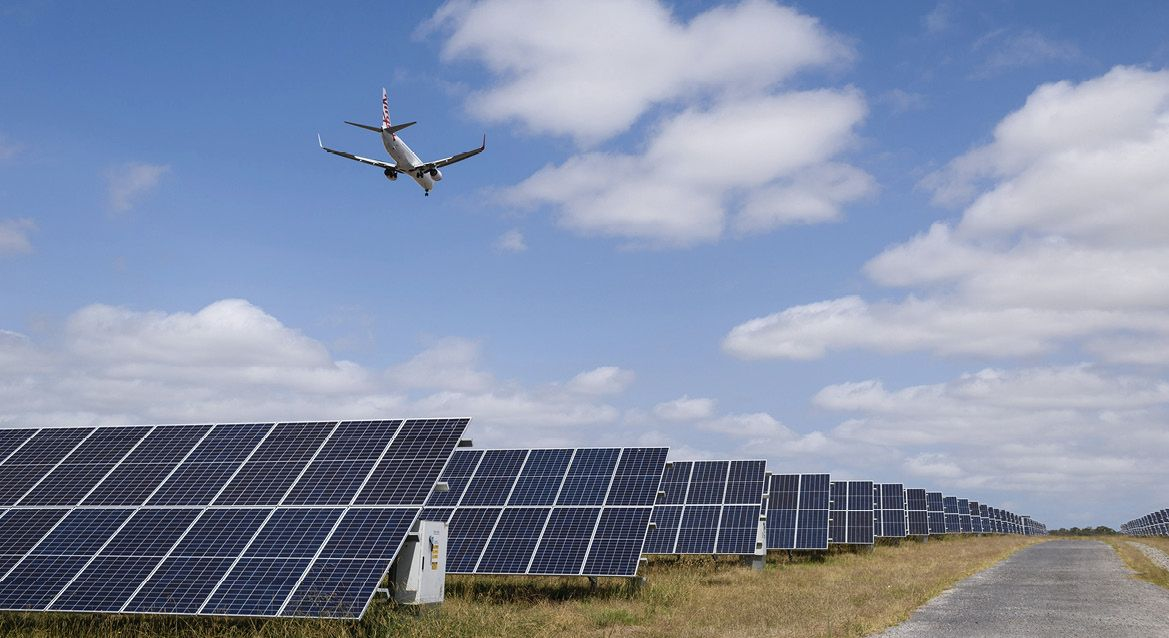In view of rising electricity prices as airports strive to reduce CO2 emissions, many aerodrome operators are turning to renewables for a secure, independent energy supply. Airports often have large undeveloped areas and flat roofs that could be considered for harvesting solar energy. Aviation emissions-reduction measures such as sustainable fuels and hydrogen and other aircraft propulsion technologies are still in development while PV is ready to roll out and can have a direct impact on the carbon footprint of airports.
There are various opportunities for airports and smaller airfields to generate economic value from rooftop PV or ground-mounted solar. Site operators can develop areas themselves to lease as “ready-to-build” sites. From a permitting perspective, the planning, installation, and operation of PV systems would then face only minor hurdles. Alternatively, an airport operator can directly invest, use solar panels for its own electricity needs or supply energy customers or traders via a power purchase agreement.
Common concerns from airport operators regarding on-site PV
However, the placement of solar arrays near aprons, taxiways, or runways can present a challenge in terms of aviation safety and regulatory compliance. There are a range of common concerns.
Addressing those questions requires a broad knowledge, and practical experience, of conducting aeronautical safety assessments and of aeronautical planning and approval processes. Airsight has conducted technical and aeronautical feasibility studies for solar near airports and other flight operation areas.
Generation potential
Maximizing the generation potential of airport PV while ensuring the already high safety level of flight operations and other processes often requires a multi-level risk assessment of potential hazards posed by panels near “aircraft maneuvering areas.” Such assessments ensure only acceptable risks exist for airport operations. It must be demonstrated to the responsible aviation approval authority that the solar system will not compromise the safety level of the airport and that aviation regulations at national and international level will be strictly followed.
Depending on airport characteristics, many requirements must be observed, from an aeronautical perspective, for the planning and approval of an airport PV system.
A hazard analysis and risk assessment of glare and irritation effects from solar installations must be carried out, as well as development of measures to reduce glare – a glare assessment.
An obstacle assessment is required, under national and supra-national regulations (such as in the EU) and an assessment of compatibility with air traffic control CNS systems must also be performed.
Developers will need a hazard analysis and risk assessment of the impact of solar arrays on runway safety, for instance in the case of unplanned veer-off of aircraft from the runway, or any impact on the evacuation of aircraft in case of accidents.
An assessment of any impact on emergency response by RFFS is needed, as is an impact assessment for wildlife management, for instance as a result of increased breeding activity of birds
Also, compliance checks must be carried out in relation to regulations regarding aerodrome design and certification.
Interdisciplinary expertise in hazard analysis and risk assessment is necessary for processing the test criteria for PV at or near airports, covering sustainable aviation, airfield planning and approval, safety of air traffic operations, and aviation obstacles and CNS installations. This requires extensive knowledge and experience with national and international specifications, standards, and norms for airfield design and management.
Success stories
Big airports such as Edmonton in Canada, Washington-Dulles in the United States, and most recently, Frankfurt in Germany, are operating or planning open-space PV systems near taxiways and runways. In May 2022, a 24 MW solar system was commissioned at Vienna-Schwechat Airport, in Austria, around 200 meters from the runway. The airport says the project is the largest ground-mounted solar system in Austria and, together with the rooftop systems already installed at the site, covers around a third of the airport’s annual electricity consumption.
The solar potential of airports is clear when looking at the length of runways. A 4 km runway, such as that found at Munich International Airport in Germany, could accommodate a 50-meter wide, 3 km long solar site that could generate around 17 GWh per year with an installed capacity of 15 MW – all in line with safety and regulatory requirements.
The energy transition requires that previous principles be broken down, new ideas be developed, and the exploitation of existing renewable energy potential also be evaluated at safety-critical infrastructure such as airports.
The areas required for solar are available at many airports, in some cases on a large scale, and could make a significant contribution as long as they do not compromise the high level of safety in aviation.

About the author: Christoph Struempfel studied aeronautics and astronautics at TU Berlin and is a consultant for sustainable aviation at airsight GmbH. The Berlin-based consultancy specializes in aviation safety assessments, inspection and engineering services, and training courses for airports, air navigation services, and aviation authorities worldwide.
The views and opinions expressed in this article are the author’s own, and do not necessarily reflect those held by pv magazine.
This content is protected by copyright and may not be reused. If you want to cooperate with us and would like to reuse some of our content, please contact: editors@pv-magazine.com.



By submitting this form you agree to pv magazine using your data for the purposes of publishing your comment.
Your personal data will only be disclosed or otherwise transmitted to third parties for the purposes of spam filtering or if this is necessary for technical maintenance of the website. Any other transfer to third parties will not take place unless this is justified on the basis of applicable data protection regulations or if pv magazine is legally obliged to do so.
You may revoke this consent at any time with effect for the future, in which case your personal data will be deleted immediately. Otherwise, your data will be deleted if pv magazine has processed your request or the purpose of data storage is fulfilled.
Further information on data privacy can be found in our Data Protection Policy.